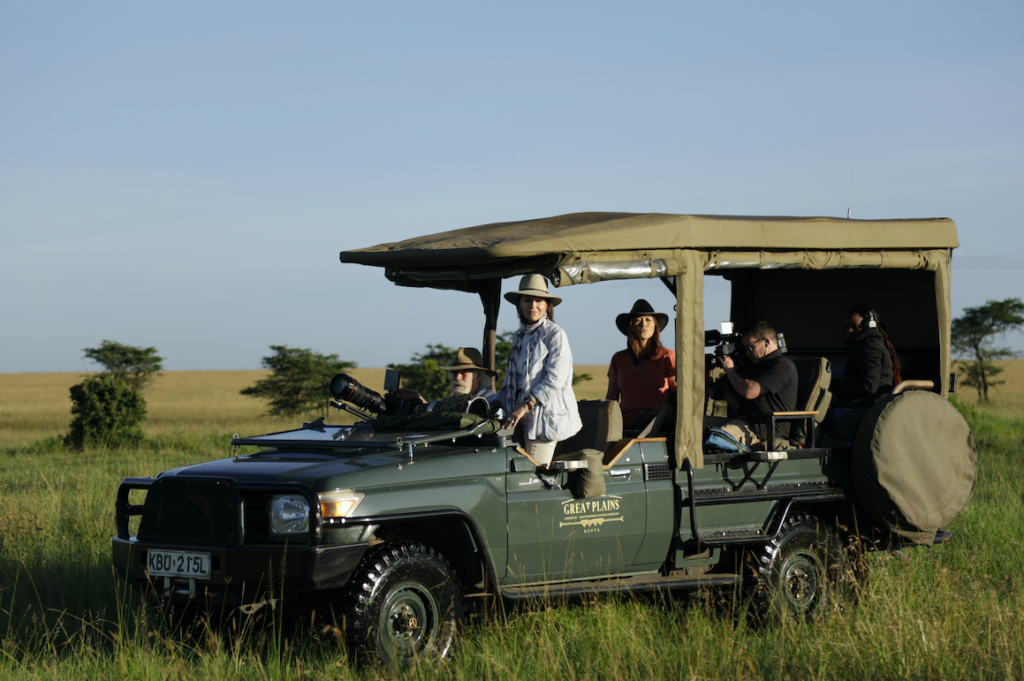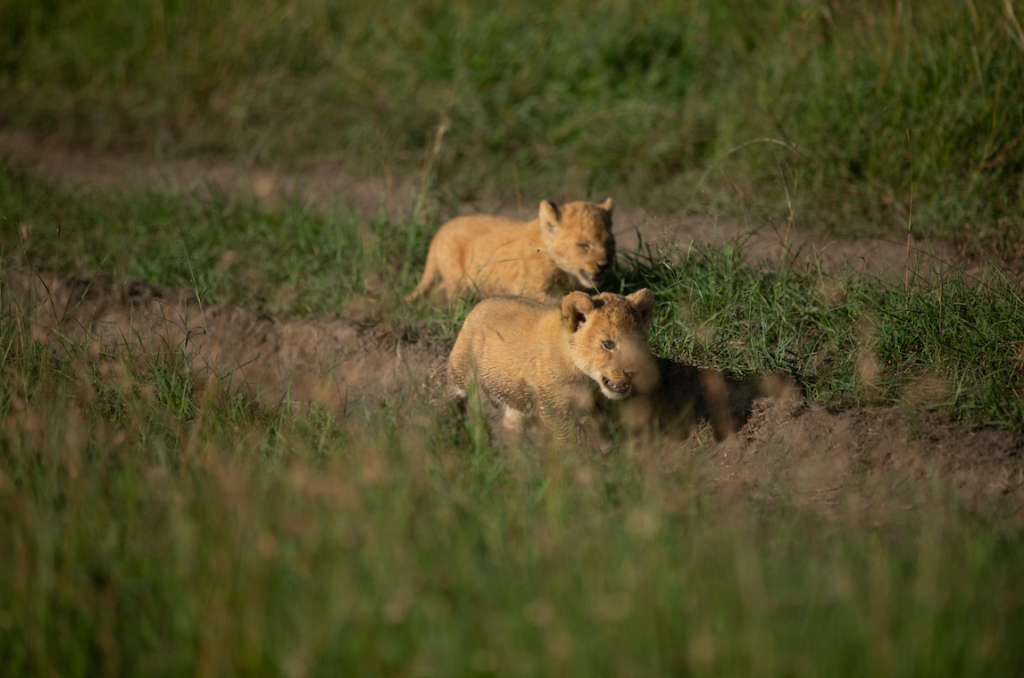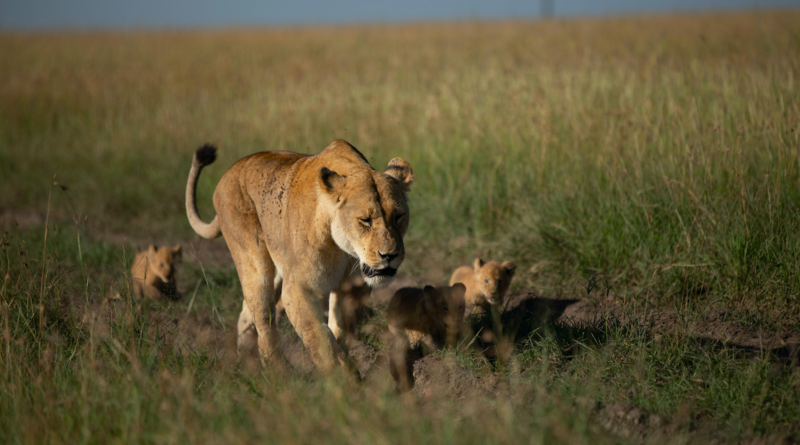INTERVIEW: Beverly and Dereck Joubert on their life of filming Africa’s big cats
Photo: A mother lion and her cubs walk along the Masai Mara plains in Kenya. Photo courtesy of National Geographic / Provided by pressroom with permission.
The sight of a maned lion wagging its tail, opening its toothed grin for an elongated yawn and scoping out the landscape for any possible dangers or opportunities is an image that for most people is relegated to the television screen. Some individuals may be lucky to catch a big cat in a zoo-like setting, and a few may experience a once-in-a-lifetime opportunity to take a safari in Kenya, South Africa, Botswana or another African nation.
For Beverly and Dereck Joubert, seeing that roaring lion can be a daily occurrence. The filmmakers, who have been working in Africa for decades, are two of the most respected conservationists and adventurers in the world. Their photographic and cinematographic output is unparalleled, resulting in numerous TV specials, films, photographs and books. The awards have stacked up over the years, and the accolades keep coming on a regular basis. But for them it seems like these extras all icing on the cake; their real motive is to find more excuses to leave one world behind and head toward the bountiful environs of the African bush.
The Jouberts have been associated with National Geographic for much of their career, and their adventures will be highlighted on a special Earth Day program on Nat Geo and Nat Geo WILD. Born Wild: The Next Generation, which looks at the hope of animal babies around the world, is set to air Wednesday, April 22 at 8 p.m. on the two wildlife-centered networks, with streaming available on Disney+ and Hulu.
“We wanted to have a look at the next generation, so we did an audit of five prides of lions that we’ve known for a long time, just to see who had which cubs and what was going on there exactly, specifically because the old males in the area are getting old,” Dereck said in a recent phone interview. “What we found was something extraordinary. We really stumbled across new cubs that we hadn’t seen before, and that was great.”
These new cubs were found in a frequent stomping ground for the Jouberts: the savannas of Kenya, where they teamed up with Nightline co-anchor Juju Chang to scope out the landscape and find the lions. Their remarkable footage not only shows this lion pride in all of its majesty, but it serves as a clarion call for viewers to consider the lions’ loss of habitat and their continued threat from poaching and trophy hunting.
“So the old males have been pretty productive,” Beverly said. “This pride that we’ve been working with, they have a variety of different ages — so these new-born cubs; and then, of course, little cubs of about six months old, eight months old; and then teenagers ranging from anything from 1 year to 2 years. So it was quite a phenomenal pride, and the interaction was extreme. And the play was extreme.”
[Read Hollywood Soapbox’s interview with fellow National Geographic Explorer Brian Skerry.]
Dereck said finding a particular pride of lions in the wild is their “secret sauce.” They have been documenting so many of these animals that there’s a real bond and understanding of their individual life’s progression. The married couple wake up in the bush and plan out a strategy for finding the big cats they saw the day before; this isn’t a sixth sense, more like a well-thought-out guessing game based on clues left behind.
“[Much] of the work that we have done with lions has been over long periods of time,” Dereck said. “We find a pride of lions, and then we get to know them, and allow them to get to know us, and basically move in with them and spend as much time as we can. And through that process, we break down that barrier and build up their trust between us, so there’s that. Also, we can identify these lions, and each lion is different. And each has a different whisker pattern, and so we know individuals within the pride, much like we would know you if we met you again. The way that it really starts for us is we’re up really early in the morning — 4 in the morning, 4:30 — and we head out so that we’re in position in the area of a lion’s territory. So we find the territory, and we can get into the epicenter of that. And then we sit down, and we listen. We listen for lion calls. We listen to the lions roaring. … We have a very, very high success rate in finding the lions we’re going after.”
The Jouberts are not simply interested in documenting these large cats and celebrating with the audience in the thrill of the chase. There’s a real environmentalism behind their work because both Dereck and Beverly understand that the dangers facing lions and other species are real, and one day these exquisite scenes that play out like soap operas on the savanna can be gone forever.
“[Conservation] did actually come early in our careers because what we were seeing in the area that we were working in is that safari hunting was allowed, and we started seeing animals decline pretty much in the first 10 years,” Beverly said. “We actually even did a film that is called Patterns in the Grass, and the zebra migration went from 45,000 down to 7,000. That is alarming, and so we started to investigate and research what the reasons were. And, of course, the safari hunting was not only coming to hunt the trophy, but they were also allowing open season pretty much on zebras so that a trade in the zebra skins could happen. … Obviously all of our films we would show to the president at the time in the country — this was in Botswana — and slowly policies were changed.”


The remaining places in Africa where large mammals still roam free are dwindling, but many of them are now protected (at least in theory). Beverly called them reservoirs of nature, the last places on the continent of pristine environment.
“I think we were both born activists, conservation activists, and then there were certain trigger points through our lives,” Dereck added. “[For example], we spent four years working with this leopard and looking into her eyes every day, understanding that during that four-year period of time 10,000 leopards had been hunted legally, and so we realized that there are all these individual characters and personalities in the big cat world that are as unique. Each one is unique, and we needed to say something about that.”
One of the Jouberts’ favorite places to capture footage — both video and still photography — is the Okavango Delta in Botswana. The inland delta system, with its flooded rivers and jaw-dropping vistas, has an explosion of fauna and flora, a real bounty of riches for the filmmaking team.
“When we were just out of university and college, we went up into the Okavango and fell in love with it immediately,” Dereck said. “It’s funny that one thing that really triggered it for me as a young explorer was that it was the one place in Africa that you could go to, and get lost, and possibly disappear and nobody would bother, so a real remoteness about it and a texture of unknown fear to a degree, but also the pristine nature that is untouched.”
Working in the delta system can be trying. There is no grounded electricity and the nearest town — Maun, Botswana — is a plane ride away. The only buildings that stand are the lodges and chalets of game reserves. Airstrips and roads look identical: dusty corridors with overgrown grass, the occasional warthog inspecting the ground.
The Jouberts head into such an environment and need to bring back photos and video footage that can run in National Geographic magazine and on the Nat Geo TV channel. That’s almost like a fool’s errand: head into the middle of nowhere to capture unbelievable images of animals, but don’t rely on any modern conveniences.
Still, they have a strategy to plow through and journey forward.
“We work many hours in the day, probably 14 to 16 out in the field, and we’re pretty organized with our little vehicle that has everything,” Beverly said. “And, of course, we have inverters, so we can charge. We even sometimes carry a sort of shower so that we can cool off during the day, but a lot of the time we’ll just plunge into the Okavango. … We don’t have many hours in the evening because we stretch our day. We start at 4:30 in the morning and get back into the dark. Those evenings are all about recharging, recharging our own batteries, recharging the camera battery, downloading all the footage and even starting a little edit to understand what we’ve got and preparing food for the day, so that is quite a challenge. It’s really time. We’ve got the luxury of time of being there, but it seems like we’ve never got enough time. We never really want to go back to camp because if you’re in camp, you’re not going to get anything [on camera].”
[Read Hollywood Soapbox’s interview with Dr. Jane Goodall.]
Dereck added: “Many people underestimate what it takes just to live, let alone get out, and film and then get something that’s interesting that’s never been seen before. We’re collecting wood for the fire and to make a meal. You’re surviving 80 percent of the time and then efficiently working 20 percent of the time.”
The many projects that the Jouberts are responsible for — from the films Birth of a Pride and The Last Lions to the books The Eye of the Leopard and The Africa Diaries — have given the world many images of African mammals, in particular large cats. Many of these viewers will live their entire life never setting foot in the African bush, and yet they have seen the birth and rearing of lion cubs, the fight for territory in the Okavango Delta, the great migrations of land animals and the lazy lounging of a jaguar in a tree — all images the Jouberts have captured and given to the world.
“While that’s gratifying, that’s also a massive burden of responsibility — a) to get it right, b) to go beyond the lens and to make sure that the conservation work that we’re involved in will trump up these animals, these areas, that this pristine nature is there beyond just the representation through our films,” Dereck said. “I don’t think everybody should rush out to Africa and experience it first-hand. I hope that we provide a service in being able to bring at least some modicum of a representation to people’s living rooms and televisions, but it is a tremendous burden.”
This burden helps motivate Beverly and Dereck with their projects. They are determined to get the shot, to document the behavior, to spread awareness about these animals — in other words, to save these species by letting the audience know these creatures are real and alive and need help.
“It’s gratifying to know that people are soaking up nature, and appreciating it and understanding that they too can be a voice, even if it’s a voice within their governments or on social media,” Beverly said. “It is a time that we all need to help protect the environment. We can do it in many different forms. Obviously, don’t be part of trading in animal parts or buying anything that is made from these wild animals. Don’t take part in safari hunting and having a trophy on your wall. … We can’t live without wilderness. We truly can’t. They truly are the last reservoirs, and they’re also spiritual places in so many ways. For me, it’s soul food.”
Dereck added: “I’m a little less hopeful about leadership. I’m a lot more hopeful about how people around the world, the television-viewing audiences, the people who read, the people who find truth, the youth, will rise up and say enough is enough. We need to interact with our planet in a different way, and we’re starting to see that happen already.”
By John Soltes / Publisher / John@HollywoodSoapbox.com
Born Wild: The Next Generation, featuring Beverly and Dereck Joubert, will air Wednesday, April 22 at 8 p.m. on Nat Geo and Nat Geo WILD, with streaming on Disney+ and Hulu. Click here for more information.


Wow so glad to see the Joubert’s have another documentary coming! Only problem is this message came through too late and only got this today 😢 29th!
It amazes me at how few few champions of wildlife there are in this world like the Joubert’s , Jane Goodhall, David Attenborough. On cannot imagine that if it wasn’t for these great people where would the pristine places be? Hunted out? Decimated for mans greed?
Like they say do not support any killing of trophy animals by purchasing anything made from an animal be it even a key ring with the smallest piece!
How devastating it must be and saddening for the Joubert’s with the latest hunting order on Botswana’s elephants!
Thank you for all you guys do for our natural world may you live forever!
I saw the documentary the Last Lioness. Want to know what happened to the female cub abandoned by her mom